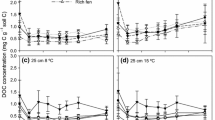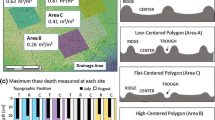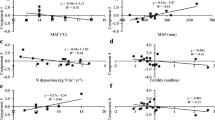Abstract
Many terrestrial soils in the US Midwest are temporally flooded during the spring. The effects of short-term flooding on biogeochemical processes that occur in these soils are not fully understood and are the subject of this study. To evaluate these processes we investigated the redox-induced changes in the soil solution for three-cultivated and three-uncultivated/forest soils with different organic matter concentrations. The soils were flooded for 1, 3, 7, and 14-days under anoxic conditions in a biogeochemical reactor. Samples were analyzed for Eh; pH; NO3 −; NH4 +; total dissolved Mn and Fe; soluble P; dissolved organic and inorganic carbon (DOC–DIC); and evolved CO2. We found strongly contrasting responses of the terrestrial soils to flooding. Reducing conditions were established quickly in the uncultivated and more slowly in the cultivated soils. Concomitant changes in pH were higher for the uncultivated soils. The uncultivated soils showed a higher increase in the amount of NH4 +, P, Fe, Mn than the cultivated soils over the 14-day incubation. The total amount of carbon decomposed was much greater for the uncultivated soils with approximately 900 μg C (CO2 + DOC + DIC) decomposed per gram of soil compared to a total decomposition of 240 μg C g −1soil for the cultivated soils indicating differences in the type of carbon decomposed. The rapid onset of reducing conditions for the uncultivated soils is attributed to a reactive carbon component that is either absent or occluded in the cultivated soils. This study demonstrates that the biogeochemically-induced changes in carbon dynamics in terrestrial soils are strongly influenced by short-term flooding and the history of soil management.









Similar content being viewed by others
Abbreviations
- ACRE:
-
Purdue University Research Farm
- Ar:
-
Argon
- DIC:
-
Dissolved inorganic carbon
- DOC:
-
Dissolved organic carbon
- DOM:
-
Dissolved organic matter
- DRP:
-
Dissolved reactive phosphorus
- Eh:
-
Redox potential
- ICP-OES:
-
Inductively coupled plasma with optical emission
- Redox:
-
Reduction–oxidation
- TOC:
-
Total organic carbon
References
Bridgham SD, Updegraff K, Pastor J (1998) Carbon, nitrogen, and phosphorus mineralization in northern wetlands. Ecology 79:1545–1561
Chantigny MH (2003) Dissolved and water-extractable organic matter in soils: a review on the influence of land use and management practices. Geoderma 113:357–380
D’Angelo EM, Reddy KR (1994) Diagenesis of organic matter in a wetland receiving hypereutrophic lake water. II. Role of inorganic electron acceptors in nutrient release. J Environ Qual 23:937–943
De-Campos AB (2006) Effects of redox on the solution chemistry and aggregate stability of Midwest upland soils. PhD Thesis, Purdue University, West Lafayette, IN
De-Campos AB, Mamedov AI, Huang C (2009) Short-term reducing conditions decrease soil aggregation. Soil Sci Soc Am J 73:550–559
Evangelou VP (1998) Environmental soil and water chemistry. Wiley, New York
Fernando W, Xia K, Rice CW (2005) Sorption and desorption of ammonium from liquid swine waste in soils. Soil Sci Soc Am J 69:1057–1065
Fiedler S, Kalbitz K (2003) Concentrations and properties of dissolved organic matter in forest soils as affected by the redox regime. Soil Sci 168:793–801
Gao S, Tanji KK, Scardaci SC et al (2002) Comparison of redox indicators in a paddy soil during rice-growing season. Soil Sci Soc Am J 66:805–817
Grybos M, Melanie D, Gruau G et al (2007) Is trace metal release in wetland soils controlled by organic matter mobility or Fe-oxyhydroxides reduction? J Colloid Interface Sci 314:490–501
Gu BH, Schmitt J, Chen ZH et al (1994) Adsorption and desorption of natural organic-matter on iron-oxide—mechanisms and models. Environ Sci Tech 28:38–46
Gu BH, Schmitt J, Chen Z et al (1995) Adsorption and desorption of different organic-matter fractions on iron-oxide. Geochim Cosmochim Acta 59:219–229
Hutchison KJ, Hesterberg D (2004) Dissolution of phosphate in a phosphorus-enriched ultisol as affected by microbial reduction. J Environ Qual 33:1793–1802
Jardine PM, Weber NL, McCarthy JF (1989) Mechanisms of dissolved organic-carbon adsorption on soil. Soil Sci Soc Am J 53:1378–1385
Kalbitz K, Solinger S, Park JH et al (2000) Controls on the dynamics of dissolved organic matter in soils: a review. Soil Sci 165:277–304
Kirk GJD, Solivas JL, Alberto MC (2003) Effects of flooding and redox conditions on solute diffusion in soil. Eur J Soil Sci 54:617–624
Lins HF, Slack JR (1999) Streamflow trends in the United States. Geophys Res Lett 26:227–230
Loeppert RL, Inskeep WP (1996) Iron. In: Sparks DL (ed) Methods of soil analysis. Part 3. Chemical methods, SSSA, Book Ser. 5. SSSA, Madison
Narteh LT, Sahrawat KL (2000) Ammonium in solution of flooded West African soils. Geoderma 95:205–214
Patrick WH, Jugsujinda A (1992) Sequential reduction and oxidation of inorganic nitrogen, manganese, and iron in flooded soil. Soil Sci Soc Am J 56:1071–1073
Peretyazhko T, Sposito G (2005) Iron(III) reduction and phosphorous solubilization in humid tropical forest soils. Geochim Cosmochim Acta 69:3643–3652
Peters V, Conrad R (1996) Sequential reduction processes and initiation of CH4 production upon flooding of oxic upland soils. Soil Biol Biochem 28:371–382
Petruzzelli L, Celi L, Ajmone-Marsan F (2005) Effects of soil organic fractions on iron oxide biodissolution under anaerobic conditions. Soil Sci 170:102–109
Phillips IR, Greenway M (1998) Changes in water-soluble and exchangeable ions, cation exchange capacity, and phosphorus(max) in soils under alternating waterlogged and drying conditions. Commun Soil Sci Plant Anal 29:51–65
Ponnamperuma FN (1972) The chemistry of submerged soils. Adv Agron 24:29–96
Prokopy WR (1997) Determination of ammonia by flow injection analysis. In: Zellweger Analytics—Lachat instruments. Methods manual. Quickchem method 10-107-06-2-A. Zellweger Analytics, Milwaukee
Reddy KR, Patrick WH (1976) Effect of frequent changes in aerobic and anaerobic conditions on redox potential and nitrogen loss in a flooded soil. Soil Biol Biochem 8:491–495
Rowell DL (1981) Oxidation and reduction. In: Greenland DJ, Hayes MHB (eds) The chemistry of soil processes. Wiley, Chichester
Scalenghe R, Edwards AC, Marsan FA et al (2002) The effect of reducing conditions on the solubility of phosphorus in a diverse range of european agricultural soils. Eur J Soil Sci 53:439–447
Schnitzer M, Khan SU (1989) Soil organic matter. Developments in soil science, vol 8. Elsevier, Amsterdam
Shenker M, Seitelbach S, Brand S et al (2005) Redox reactions and phosphorus release in re-flooded soils of an altered wetland. Eur J Soil Sci 56:515–525
Wendt K (1999) Determination of nitrate/nitrate in surface and wastewaters by flow injection analysis. In: Zellweger Analytics—Lachat instruments. Methods manual. Quickchem method 10-107-04-1-A. Zellweger Analytics, Milwaukee
Yao H, Conrad R, Wassmann R et al (1999) Effect of soil characteristics on sequential reduction and methane production in sixteen rice paddy soils from China, the Philippines, and Italy. Biogeochemistry 47:269–295
Zhang Y, Scherer HW (2000) Mechanisms of fixation and release of ammonium in paddy soils after flooding. II. Effect of transformation of nitrogen forms on ammonium fixation. Biol Fertil Soils 31:517–521
Zibilske LM (1994) Carbon mineralization. In: Weaver RW (ed) Methods of soil analysis. Part 2. Microbiological and biochemical properties, SSSA Book Ser. 5. SSSA, Madison
Author information
Authors and Affiliations
Corresponding author
Rights and permissions
About this article
Cite this article
De-Campos, A.B., Huang, Ch. & Johnston, C.T. Biogeochemistry of terrestrial soils as influenced by short-term flooding. Biogeochemistry 111, 239–252 (2012). https://doi.org/10.1007/s10533-011-9639-2
Received:
Accepted:
Published:
Issue Date:
DOI: https://doi.org/10.1007/s10533-011-9639-2




